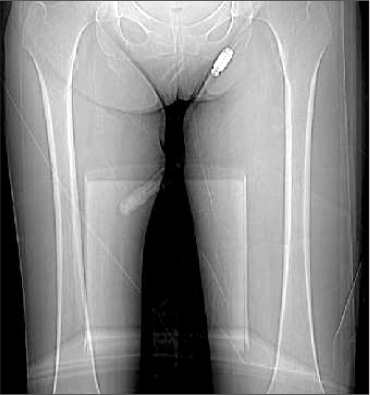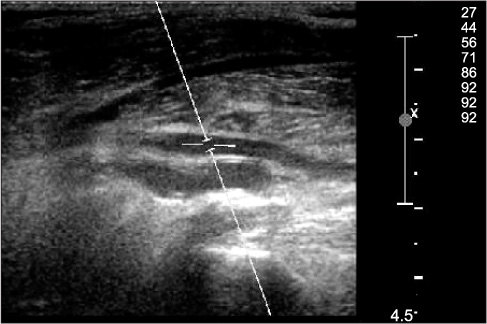J Korean Orthop Assoc.
2012 Feb;47(1):69-74. 10.4055/jkoa.2012.47.1.69.
Diabetic Muscle Infarction in Thigh
- Affiliations
-
- 1Department of Orthopedic Surgery, Eulji General Hospital, Eulji University College of Medicine, Seoul, Korea. bsw2402@eulji.ac.kr
- 2Department of Radiology, Eulji General Hospital, Eulji University College of Medicine, Seoul, Korea.
- KMID: 1439996
- DOI: http://doi.org/10.4055/jkoa.2012.47.1.69
Abstract
- Although ischemia in the distal areas of the limbs due to vascular occlusion is a well recognized systemic condition in patients who have diabetes, infarction of skeletal muscle, not associated with gangrene, is exceedingly rare and the paucity of published cases focused on this condition makes it difficult to determine the most appropriate methods of diagnosis and treatment. The authors encountered a case of diabetic muscle infarction with exquisitely tender swelling on the anteromedial aspect of thigh and herein report the diagnostic work-up and treatment performed on the patient.
Keyword
Figure
Reference
-
1. Angervall L, Steiner B. Tumoriform focal muscular degeneration in two diabetic patients. Diabetalogia. 1965. 1:39–42.
Article2. Aboulafia AJ, Monson DK, Kennon RE. Clinical and radiological aspects of idiopathic diabetic muscle infarction. Rational approach to diagnosis and treatment. J Bone Joint Surg Br. 1999. 81:323–326.3. Chester CS, Banker BQ. Focal infarction of muscle in diabetics. Diabetes Care. 1986. 9:623–630.
Article4. Damron TA, Levinsohn EM, McQuail TM, Cohen H, Stadnick M, Rooney M. Idiopathic necrosis of skeletal muscle in patients who have diabetes. Report of four cases and review of the literature. J Bone Joint Surg Am. 1998. 80:262–267.5. Lauro GR, Kissel JT, Simon SR. Idiopathic muscular infarction in a diabetic patient. Report of a case. J Bone Joint Surg Am. 1991. 73:301–304.
Article6. Hinton A, Heinrich SD, Craver R. Idiopathic diabetic muscular infarction: the role of ultrasound, CT, MRI, and biopsy. Orthopedics. 1993. 16:623–625.
Article7. Morcuende JA, Dobbs MB, Crawford H, Buckwalter JA. Diabetic muscle infarction. Iowa Orthop J. 2000. 20:65–74.8. Umpierrez GE, Stiles RG, Kleinbart J, Krendel DA, Watts NB. Diabetic muscle infarction. Am J Med. 1996. 101:245–250.
Article9. Pope TL, Bloem HL, Beltran J, Morrison WB, Wilson DJ. Imaging of the musculoskeletal system. 2008. 1st ed. Philadelphia: Saunders;1035.10. Delaney-Sathy LO, Fessell DP, Jacobson JA, Hayes CW. Sonography of diabetic muscle infarction with MR imaging, CT, and pathologic correlation. AJR Am J Roentgenol. 2000. 174:165–169.
Article
- Full Text Links
- Actions
-
Cited
- CITED
-
- Close
- Share
- Similar articles
-
- Acute Compartment Syndrome in Association with Spontaneous Muscle Infarction
- Diabetic Muscle Infarction in a Chronic Stroke Patient: A Case Report
- Diabetic Muscle Infarction in Diabetes; Three cases report
- Recurrent Muscle Infarction in a Diabetic Hemodialysis Patient
- Case of Recurrent Diabetic Muscle Infarction Related to Strict Blood Glucose Control





